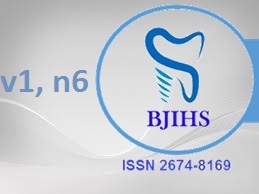Resumo
Introdução: A terapia com implantes dentários é um tratamento de escolha na falta de dentes. No entanto, certas condições como tabagismo, hipertensão e diabetes têm influência negativa no sucesso dos implantes dentários. A nicotina pode causar alterações osteoclásticas. O presente estudo foi realizado para avaliar a relação entre nicotina e falha do implante.
Materiais e métodos: O presente estudo retrospectivo incluiu 2570 pacientes de ambos os sexos. Eles foram divididos em dois grupos. O grupo I consistiu de 1250 pacientes com histórico de tabagismo e o grupo II não fumantes e 1320 pacientes. A presença de dor, mobilidade e inflamação foi considerada um sinal positivo para falha do implante.
Resultados: Os resultados mostraram que no grupo I, os homens apresentavam 6,13% e as mulheres, 5%, falha do implante dentário. A taxa geral de falhas no grupo I foi de 5,56%. No grupo II, o sexo masculino teve 2,98% e o feminino, 0,9% de falha. A taxa geral de falhas no grupo II foi de 2,35%. A diferença entre os dois grupos foi estatisticamente significante ( P <0,05). No grupo I, máximo (56), e no grupo II, 18 pacientes tinham hábito> 10 anos de tabagismo. O número máximo de pacientes tinha o hábito de consumo> 20 cigarros / dia (Grupo I) e o Grupo II possuía apenas 10 pacientes com essa frequência. Foram observadas falhas máximas no implante dentário no arco maxilar (70) do que no arco mandibular (32). A diferença foi estatisticamente significante ( P <0,05).
Conclusão: O tabagismo influencia a taxa de sobrevivência dos implantes dentários. Assim, o paciente deve ser educado para interromper o hábito antes da colocação do implante.
Referências
2. MacFarlane GD, Herzberg MC, Wolff LF, Hardie NA. Refractory periodontitis associated with abnormal polymorphonuclear leukocyte phagocytosis and cigarette smoking. J Periodontol. 1992;63:908–13.
3. Siana JE, Rex S, Gottrup F. The effect of cigarette smoking on wound healing. Scand J Plast Reconstr Surg Hand Surg. 1989;23:207–9
4. Friberg B, Jemt T, Lekholm U. Early failures in 4,041 consecutively placed Brånemark dental implants: A study from stage I surgery to the connection of prosthesis. Int J Oral Maxillofac Implants. 1991;6:142–6.
5. Strietzel FP, Reichart PA, Kale A, Kulkarni M, Wegner B, Küchler I, et al. Smoking interferes with the prognosis of dental implant treatment: A systematic review and meta-analysis. J Clin Periodontol. 2007;34:523–44
6. Bain CA, Moy PK. The association between the failure of dental implants and cigarette smoking. Int J Oral Maxillofac Implants. 1993;8:609–15.
7. Alsaadi G, Quirynen M, Komárek A, van Steenberghe D. Impact of local and systemic factors on the incidence of late oral implant loss. Clin Oral Implants Res. 2008;19:670–6
8. Haas R, Haimböck W, Mailath G, Watzek G. The relationship of smoking on peri-implant tissue: A retrospective study. J Prosthet Dent. 1996;76:592–6.
9. Balshe AA, Eckert SE, Koka S, Assad DA, Weaver AL. The effects of smoking on the survival of smooth – And rough-surface dental implants. Int J Oral Maxillofac Implants. 2008;23:1117–22.
10. Kumar A, Jaffin RA, Berman C. The effect of smoking on achieving osseointegration of surface-modified implants: A clinical report. Int J Oral Maxillofac Implants. 2002;17:816–9
11. Twito D, Sade P. The effect of cigarette smoking habits on the outcome of dental implant treatment. PeerJ. 2014;2:e546
12. Peleg M, Garg AK, Mazor Z. Healing in smokers versus nonsmokers: Survival rates for sinus floor augmentation with simultaneous implant placement. Int J Oral Maxillofac Implants. 2006;21:551–9.
13. Arora A, Reddy MM, Mhatre S, Bajaj A, Gopinath PV, Arvind P. Comparative evaluation of effect of smoking on survival of dental implant. J Int Oral Health. 2017;9:24–7
14. Henemyre CL, Scales DK, Hokett SD, Cuenin MF, Peacock ME, Parker MH, et al. Nicotine stimulates osteoclast resorption in a porcine marrow cell model. J Periodontol. 2003;74:1440–6
15. Ma L, Zwahlen RA, Zheng LW, Sham MH. Influence of nicotine on the biological activity of rabbit osteoblasts. Clin Oral Implants Res. 2011;22:338–42
16. Lindquist LW, Carlsson GE, Jemt T. Association between marginal bone loss around osseointegrated mandibular implants and smoking habits: A 10-year follow-up study. J Dent Res. 1997;76:1667–74
17. Patrick D, Zosky J, Lubar R, Buchs A. Longitudinal clinical efficacy of core-vent dental implants: A five-year report. J Oral Implantol. 1989;15:95–103.
18. Goodacre CJ, Bernal G, Rungcharassaeng K, Kan JY. Clinical complications with implants and implant prostheses. J Prosthet Dent. 2003;90:121–32
19. Truhlar RS, Orenstein IH, Morris HF, Ochi S. Distribution of bone quality in patients receiving endosseous dental implants. J Oral Maxillofac Surg. 1997;55:38–45
20. DeLuca S, Habsha E, Zarb GA. The effect of smoking on osseointegrated dental implants. Part I: Implant survival. Int J Prosthodont. 2006;19:491–8.
21. Schwartz-Arad D, Samet N, Samet N, Mamlider A. Smoking and complications of endosseous dental implants. J Periodontol. 2002;73:153–7.
22. César-Neto JB, Benatti BB, Sallum EA, Casati MZ, Nociti FH., Jr The influence of cigarette smoke inhalation and its cessation on the tooth-supporting alveolar bone: A histometric study in rats. J Periodontal Res. 2006;41:118–23.
OS AUTORES DECLARAM NÃO HAVER CONFLITOS DE INTERESSE / THE AUTHORS DECLARE NO CONFLICTS OF INTEREST
Os autores são detentores dos direitos autorais mediante uma licença CCBY 4.0.

